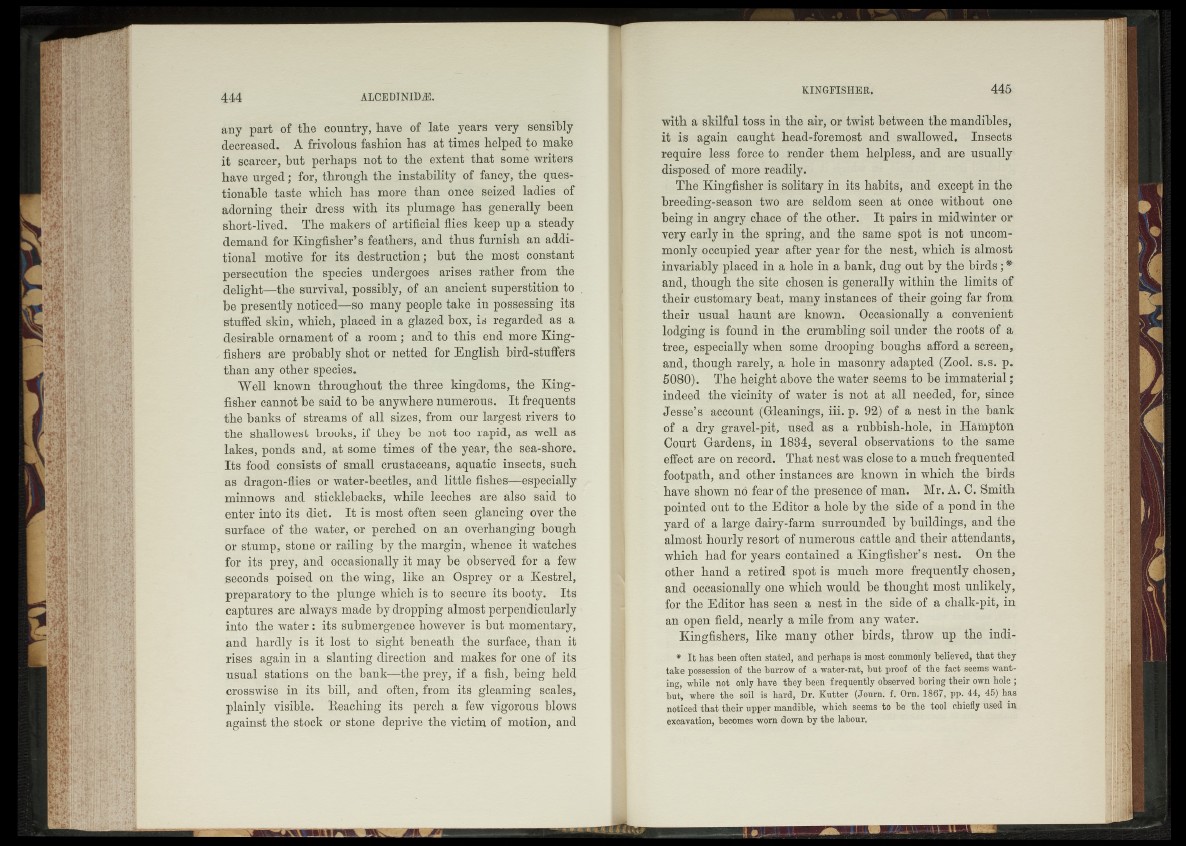
any part of the country, have of late years very sensibly
decreased. A frivolous fashion has at times helped to make
it scarcer, hut perhaps not to the extent that some writers
have urged; for, through the instability of fancy, the questionable
taste which has more than once seized ladies of
adorning their dress with its plumage has generally been
short-lived. The makers of artificial flies keep up a steady
demand for Kingfisher’s feathers, and thus furnish an additional
motive for its destruction; but the most constant
persecution the species undergoes arises rather from the
delight—the survival, possibly, of an ancient superstition to
he presently noticed—so many people take in possessing its
stuffed skin, which, placed in a glazed box, is regarded as a
desirable ornament of a room ; and to this end more Kingfishers
are probably shot or netted for English bird-stuffers
than any other species.
Well known throughout the three kingdoms, the Kingfisher
cannot he said to be anywhere numerous. It frequents
the hanks of streams of all sizes, from our largest rivers to
the shallowest brooks, if they be not too rapid, as well as
lakes, ponds and, at some times of the year, the sea-shore.
Its food consists of small crustaceans, aquatic insects, such
as dragon-flies or water-beetles, and little fishes—especially
minnows and sticklebacks, while leeches are also said to
enter into its diet. It is most often seen glancing over the
surface of the water, or perched on an overhanging bough
or stump, stone or railing by the margin, whence it watches
for its prey, and occasionally it may be observed for a few
seconds poised on the wing, like an Osprey or a Kestrel,
preparatory to the plunge which is to secure its booty. Its
captures are always made by dropping almost perpendicularly
into the water: its submergence however is but momentary,
and hardly is it lost to sight beneath the surface, than it
rises again in a slanting direction and makes for one of its
usual stations on the bank—the prey, if a fish, being held
crosswise in its bill, and often, from its gleaming scales,
plainly visible. Reaching its perch a few vigorous blows
against the stock or stone deprive the victim of motion, and
with a skilful toss in the air, or twist between the mandibles,
it is again caught head-foremost and swallowed. Insects
require less force to render them helpless, and are usually
disposed of more readily.
The Kingfisher is solitary in its habits, and except in the
breeding-season two are seldom seen at once without one
being in angry chace of the other. It pairs in midwinter or
very early in the spring, and the same spot is not uncommonly
occupied year after year for the nest, which is almost
invariably placed in a hole in a bank, dug out by the birds; *
and, though the site chosen is generally within the limits of
their customary beat, many instances of their going far from
their usual haunt are known. Occasionally a convenient
lodging is found in the crumbling soil under the roots of a
tree, especially when some drooping boughs afford a screen,
and, though rarely, a hole in masonry adapted (Zool. s.s. p.
5080). The height above the water seems to be immaterial;
indeed the vicinity of water is not at all needed, for, since
Jesse’s account (Gleanings, iii. p. 92) of a nest in the bank
of a dry gravel-pit, used as a rubbish-hole, in Hampton
Court Gardens, in 1884, several observations to the same
effect are on record. That nest was close to a much frequented
footpath, and other instances are known in which the birds
have shown no fear of the presence of man. Mr. A. C. Smith
pointed out to the Editor a hole by the side of a pond in the
yard of a large dairy-farm surrounded by buildings, and the
almost hourly resort of numerous cattle and their attendants,
which had for years contained a Kingfisher’s nest. On the
other hand a retired spot is much more frequently chosen,
and occasionally one which would be thought most unlikely,
for the Editor has seen a nest in the side of a chalk-pit, in
an open field, nearly a mile from any water.
Kingfishers, like many other birds, throw up the indi-
* I t has been often stated, and perhaps is most commonly believed, that they
take possession of the burrow of a water-rat, but proof of the fact seems wanting,
while not only have they been frequently observed boring their own hole ;
but, where the soil is hard, Dr. Kutter (Journ. f. Orn. 1867, pp. 44, 45) has
noticed that their upper mandible, which seems to be the tool chiefly used in
excavation, becomes worn down by the labour.